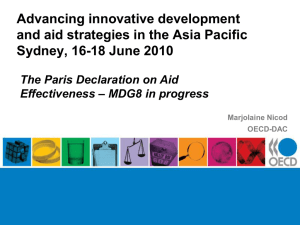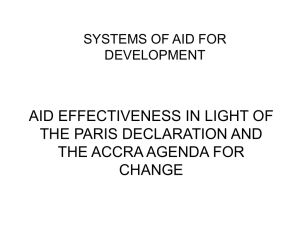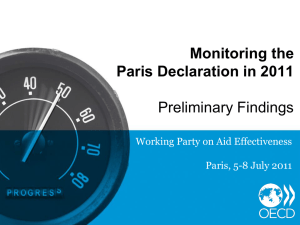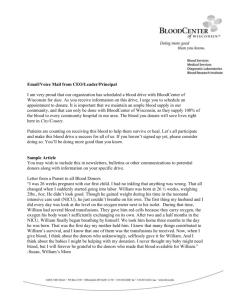TD United Nations Conference on Trade and Development United Nations
advertisement
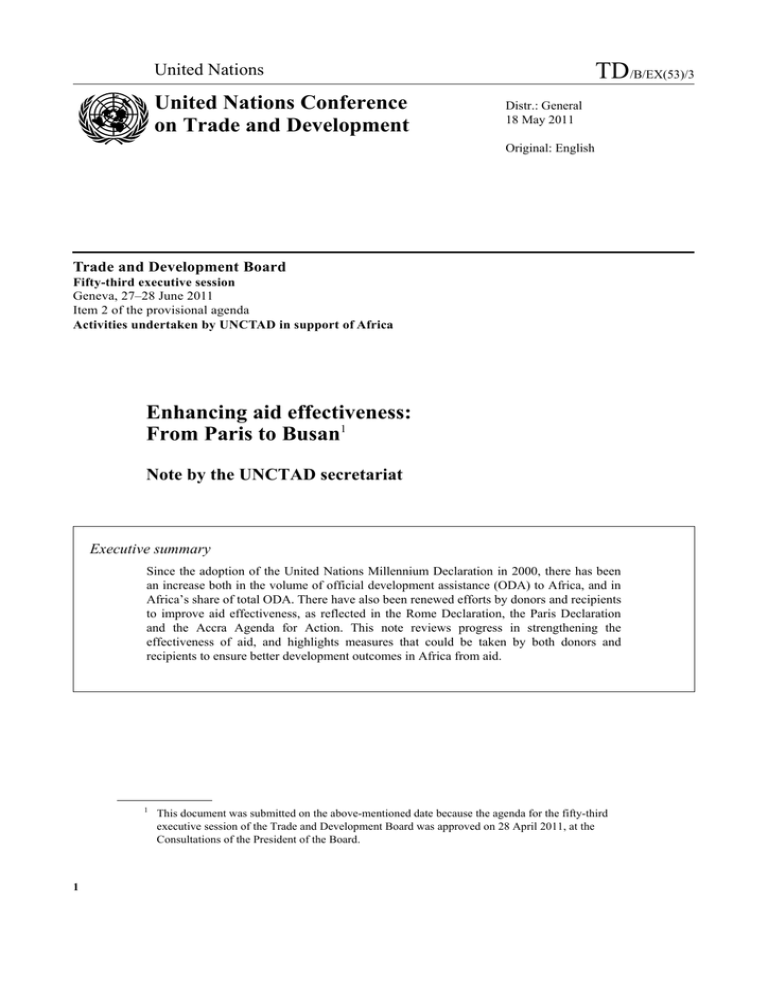
TD/B/EX(53)/3 United Nations United Nations Conference on Trade and Development Distr.: General 18 May 2011 Original: English Trade and Development Board Fifty-third executive session Geneva, 27–28 June 2011 Item 2 of the provisional agenda Activities undertaken by UNCTAD in support of Africa Enhancing aid effectiveness: From Paris to Busan1 Note by the UNCTAD secretariat Executive summary Since the adoption of the United Nations Millennium Declaration in 2000, there has been an increase both in the volume of official development assistance (ODA) to Africa, and in Africa’s share of total ODA. There have also been renewed efforts by donors and recipients to improve aid effectiveness, as reflected in the Rome Declaration, the Paris Declaration and the Accra Agenda for Action. This note reviews progress in strengthening the effectiveness of aid, and highlights measures that could be taken by both donors and recipients to ensure better development outcomes in Africa from aid. 1 1 This document was submitted on the above-mentioned date because the agenda for the fifty-third executive session of the Trade and Development Board was approved on 28 April 2011, at the Consultations of the President of the Board. TD/B/EX(53)/3 I. The context 1. Foreign aid has played and will continue to play an important role in financing economic development in Africa, particularly in the short to medium term. African countries have to make significant public investments in order to enhance their prospects for achieving the Millennium Development Goals (MDGs). However, they have very limited access to international capital markets, as well as relatively low domestic savings. Consequently, many countries in the region need official development assistance to supplement their domestic resources and to finance national development programmes (UNCTAD, 2006). The international community has recognized this critical role of finance for development, as reflected in the promises made to scale up ODA and meet existing commitments in the Millennium Declaration, the Monterrey Consensus, the 2005 World Summit Outcome, the G8 Gleneagles Summit, and the Doha Declaration on Financing for Development. 2. There has been an increase in ODA flows to Africa in recent years. In particular, ODA to the region rose from $15.3 billion in 2000 to $47.6 billion in 2009. This represents an increase in Africa’s share of the total ODA to developing countries from 31 per cent in 2000 to 37 per cent in 2009. With regard to bilateral ODA to Africa from the Development Assistance Committee (DAC) members of the Organization for Economic Cooperation and Development (OECD), it increased from $10 billion in 2000 to $28 billion in 2009. Despite the increase, donors are yet to fulfil the commitments made to double aid to Africa by 2010 relative to 2004 levels. The 2010 MDG Gap Task Force Report suggests that the shortfall in aid delivery to Africa in 2010 is $16 billion (in 2009 prices). There is a need for donors to scale up efforts to meet their aid commitments to Africa so as to increase the resources available for development in the region and to enhance the ability of African countries to respond to current and emerging challenges. 3. While the volume of ODA is important, there is growing recognition that the quality of ODA also matters and is critical to maximizing the development impact of aid. Consequently, efforts have been made by the international community to enhance aid effectiveness, as evidenced by agreements reached at the three high-level forums on aid effectiveness held in Rome (2003), Paris (2005) and Accra (2008).2 In the Rome Declaration, donors outlined the core principles for aid effectiveness, and agreed to improve the way in which aid is delivered. However, the Rome meeting was largely a donor event, and so did not lead to binding commitments by donors and recipients. The Paris Declaration represented the first attempt by both donors and recipients to commit to taking specific steps to improve aid effectiveness based on five principles – ownership, alignment, harmonization, development results, and mutual accountability. 4. The 2010 report entitled Mutual Review of Development Effectiveness in Africa: Promise and Performance, published jointly by OECD and the United Nations Economic Commission for Africa (UNECA), indicates that there has been very slow progress in meeting most of the targets set in the Paris Declaration.3 For example, while there has been significant progress in untying aid, as well as in aligning and coordinating technical 2 3 2 For a detailed timeline of the aid effectiveness agenda, see annex I. This assessment is based on the results of the OECD/DAC 2008 monitoring survey on progress in meeting the Paris Declaration commitments. TD/B/EX(53)/3 assistance, there has been very little improvement in recording ODA in recipient countries’ budgets, reducing aid unpredictability, coordination of donor missions, and reduction of the overall transaction costs of aid delivery. In light of this limited progress, the Accra Agenda for Action identified further steps to be adopted by development partners to enhance the prospects of achieving the Paris Declaration commitments by 2010. In particular, it was agreed that improvements were needed in the areas of ownership, partnerships, and delivering results. The upcoming Fourth High-Level Forum on Aid Effectiveness, to be held in Busan, Republic of Korea, provides an opportunity for the international community to further assess the progress in meeting the commitments and targets set in the Paris Declaration and the Accra Agenda for Action. It is also an opportunity for donors to specify the concrete actions they will take to fulfil their existing aid commitments to Africa. 5. Against this background, this paper highlights a set of selected measures that are essential for moving the aid effectiveness agenda forward. Furthermore, it offers some suggestions on how the forthcoming Busan conference could contribute to enhancing aid and development effectiveness in Africa. Finally, it presents some key questions for discussion. II. Selected priority measures needed to move the aid effectiveness agenda forward on the donors’ side 6. This section discusses four priority measures that donors could adopt to move the aid effectiveness agenda forward. The measures highlighted are based on issues raised in the growing literature on aid effectiveness, and are by no means exhaustive. Other issues which are of relevance to the improvement of aid effectiveness, but which are not emphasized here, include the untying of aid, and the need to improve aid allocation to ensure that it goes to the countries that need it the most. 7. A higher volume of aid, as promised in past pledges and commitments, remains a precondition to improved aid effectiveness. All too often, pledges made at international gatherings such as the Monterrey Financing for Development Conference and the G8 Summit in Gleneagles have not been followed by fast disbursements. Furthermore, only a handful of countries have achieved the goal of allocating 0.7 per cent of their gross national income (GNI) to aid. Recent data show that the ratio of ODA to GNI in DAC member countries averaged about 0.32 per cent in 2010, a far cry from the stated goal. Furthermore, there are concerns about whether or not resources made available from debt relief are additional to existing aid commitments. UNCTAD (2008a) suggests that the results of calculations on the additionality (or lack of additionality) of debt relief to ODA depend on the methods and assumptions used for the analysis. 8. There is a need for donors to pay more attention to the composition or sectoral distribution of aid flows. In 2009, about 45 per cent of the total bilateral aid commitments by DAC countries went to the social sectors, while the production sectors accounted for only 8 per cent. The “needs gap” for social sectors has been repeatedly put forward in the context of achieving the MDGs. It is increasingly acknowledged that the sectoral allocation of aid also matters in determining its development impact. Research by UNCTAD (2008a) emphasizes the importance of external financing in raising the level of domestic investment in the productive sectors. UNCTAD’s analysis further shows that ODA flows targeted at economic infrastructure contribute strongly to economic growth. Such investments in capital formation in the productive sectors lead to faster growth of value-added and employment, which are essential elements of the development process. 9. There is a need for better coordination mechanisms and for a stronger commitment to abide by them. The 2008 OECD/DAC evaluation of the implementation of the Paris 3 TD/B/EX(53)/3 Declaration deemed progress on aid coordination to be weak. Lack of coordination generates risks of duplication and high transaction costs for recipient governments. The practice of joint missions, for example, remains poor. Changes in coordination practices remain few and far between. Reform of current practices is all the more pressing considering the increase in aid fragmentation over the past few years. It was estimated that there were about 340,000 development projects in 2008. Furthermore, it was estimated that by 2008, the number of key actors comprised 280 bilateral donor agencies, 242 multilateral programmes, 24 development banks, and about 40 United Nations agencies. The emergence of new donors, such as emerging countries, philanthropic organizations and private companies, has further complicated the governance of international development cooperation. There is a need for better dialogue between the emerging and traditional donors, in order to reduce the transaction costs of aid delivery in Africa. In this context, the establishment of the United Nations Development Cooperation Forum as a platform for dialogue among stakeholders is welcomed, and should be strengthened (UNCTAD, 2010). 10. There is a need for donors to demonstrate more commitment to tackle the causes of aid unpredictability. Progress in increasing the predictability of aid has been rather slow. It is estimated that about 25 per cent of aid value is lost as a result of the unpredictability of aid flows. Furthermore, an OECD survey has shown that on average, only 45 per cent of aid is delivered on schedule to recipient countries. In addition, it is estimated that an average of 33 per cent of delays or failure in disbursements are due to administrative and political problems on the donor’s side. Such delays result in difficulties in planning and executing budgets in recipient governments. Confirming the need for more predictability, and in line with other research, analysis by UNCTAD (2006) shows that uncertainty of aid disbursements has a negative impact on growth. Furthermore, the short-term focus of aid commitments clashes with the medium to long time horizon of development planning. Additional negative impacts of the unpredictability of aid include the higher likelihood of fiscal and monetary instability, and the possible need to run fiscal deficits in cases of overoptimistic projections of aid disbursements in the government’s budget. Possible remedial actions include increased government borrowing, which, in turn, could result in higher inflation rates and greater macroeconomic instability. Such negative flows of events can be averted if donors have the political will to adopt measures that would reduce the likelihood of delays on their part. 11. There is a need for donors to demonstrate their commitment to reducing the negative impact of conditionalities on domestic ownership, as a clear indication of their commitment to strengthen aid effectiveness. Policy conditionalities are rooted in donors and creditors’ concerns to safeguard the integrity of their financing and the effectiveness of their ODA and loans. However, in the 1980s and 1990s, under structural adjustment programmes, conditionality extended into requests for specific macroeconomic, fiscal and trade policy reforms. Research on the impact of policy conditionalities shows that they have not always been effective in inducing the changes in recipient countries that donors desire to see. Although the advent of poverty reduction strategies brought a switch to process-based conditionality, the influence of the conditionality approach remains strong within the donor community. In recent years, conditionalities have come to encompass good governance and institutions. As with economic policies, despite the inconclusiveness of the empirical work on the relationship between quality of institutions and policies on growth, many donors still use conditionalities as a basis for aid allocation. It should be noted, however, that traditional donors are increasingly making more efforts to address the issue of policy conditionality by streamlining the conditions attached to aid delivery. To honour their Paris commitments, donors should respond to calls for reducing or removing policy conditionalities, and let recipient governments truly own their development agenda. Without such ownership, there can be no hope for sizeable progress in strengthening aid effectiveness. 4 TD/B/EX(53)/3 III. Measures that could be adopted by African countries to improve aid effectiveness 12. Improving aid effectiveness is not the responsibility of donors alone. African governments can and should play a leadership role in strengthening aid effectiveness. In particular, they should adopt a number of priority measures that are critical to achieving this objective. 13. In partnership with the donor community, there is a need for recipient governments to strengthen their leadership in the management of aid. Doing so would reduce the transaction costs of aid, thereby improving its effectiveness. Recipient country leadership in the coordination of aid is legitimized by the Paris Declaration. The Declaration further stipulates that such leadership must be exercised in dialogue with donors, and with the participation of civil society and the private sector. More explicitly, the Declaration goes on to affirm that: “because demonstrating real progress at country level is critical, under the leadership of the partner we will periodically assess, qualitatively as well as quantitatively, our mutual progress at country level in implementing agreed commitments on aid effectiveness. In doing so, we will make use of appropriate country level mechanisms” (OECD, 2005: 3). Going one step further, research by UNCTAD (2008b) highlights the potential for recipient-led aid management policies in LDCs. Aid management policy is a means to strengthen country ownership of aid allocation in line with the country’s own development strategy. It is interrelated with but distinct from the national development strategy (UNCTAD, 2008b: 121). Examples of aid management policies include Rwanda’s Aid Policy in 2006, Uganda’s Joint Assistance Strategy for 2005–2009, and the United Republic of Tanzania’s Joint Assistance Strategy in 2006. In all three cases, the recipient country exercised leadership in the management of aid, in consultation with all other development partners. Other examples of local initiatives taken to reduce transaction costs include steps to promote joint donor missions, and restricting them to specifically allocated periods. Such practices were to a large extent enforced and have borne their fruit, thereby improving aid effectiveness. However, such initiatives remain too few. 14. There is a need to better publicize examples of clear leadership by the recipient government to illustrate the possibility for recipient countries to better assert themselves in the donor–recipient relationship. With regard to the use of national systems, for example, although it is a necessary condition for aid to be aligned to national development strategies, and a necessary condition for sustainability, it is not systematically enforced. As stated earlier, the choice of aid delivery mechanisms also impacts on aid effectiveness. Betterquality national development plans and a demonstrated and sustained good macroeconomic track record are prerequisites for the recipient government’s credibility in performing its leadership role. However, it remains the case that the poorest countries do not have the capacity to execute policies in an effective manner. They need capacity development in order to do so. While acknowledging this need, the requests for and design of such capacity-development initiatives should be country-driven and country-specific. This would, in turn, generate greater chances of exiting from aid dependency in the long run. 15. African governments should strengthen domestic resource mobilization. Although aid has an important role to play in Africa’s economic development, it is important that governments take proactive measures to achieve sustained economic growth and to lay the foundations for exiting from aid dependence in the long run. In this regard, the ultimate test of aid effectiveness is the extent to which it enables a country to enhance domestic resource mobilization and reduce aid dependence in the long run. African countries should, therefore, redouble efforts to mobilize domestic resources, and also encourage donors to direct part of their aid to boosting domestic capacity for resource mobilization (UNCTAD, 2007). 5 TD/B/EX(53)/3 16. African governments need to be more accountable to local stakeholders. One of the concerns of African countries is that their governments take the issue of accountability to donors seriously but they may pay relatively little attention to accountability to local stakeholders, such as parliament, civil society, and the private sector (UNECA and the African Union Commission, 2008). There is a need for African governments to take more specific actions to increase accountability to their local stakeholders to enhance domestic ownership of the aid process and outcome. 17. In the lead-up to Busan, it is important that African countries collectively express their views on what needs to be done to strengthen aid effectiveness. African countries should not repeat previous instances of missed opportunities for a common and unified vision. Regional initiatives – such as the recently launched Africa Platform for Development Effectiveness coordinated by the African Union Commission and the NEPAD Planning and Coordinating Agency – are important in preparing African countries for the Busan meeting and in ensuring that they have a common position on how to move the process forward. IV. The Busan conference and aid effectiveness in Africa 18. The objectives of the Fourth High-Level Forum on Aid Effectiveness, to be held in Busan from 29 November to 1 December 2011, are as follows: (a) to assess global progress in improving the quality of aid against the agreed commitments; (b) to share global experiences in delivering the best results; and (c) to agree on a Busan Outcome Document to further enhance efforts globally and within countries to make aid more effective in reducing poverty and achieving the Millennium Development Goals. A number of workshops have been conducted both globally and within Africa as part of the preparations for the Busan conference. One of the ideas emanating from these events is the need for a new global development partnership to be developed in Busan to allow for the increasing complexity of international development. The Busan forum will draw on evidence from the ongoing Third Monitoring Survey of 90 countries, 44 of which are African. The high number of African countries participating in the monitoring exercises should result in a strong African specificity in the evidence used during the forum. It would therefore be appropriate and timely that, in addition to specific themes of interest to all aid-receiving countries, African countries use the Busan forum as an opportunity to highlight their priorities and concerns on aid effectiveness. In addition to the measures listed in previous sections, the other priorities are outlined in the following two paragraphs. 19. Move from aid to development effectiveness: There is growing recognition in Africa of the need for a shift of emphasis from aid to development effectiveness. The reasoning is that although useful, the focus on aid effectiveness is too limited to aid-delivery mechanisms and other administrative issues. It is felt that a broadening of the debate and discussions towards development effectiveness will provide more opportunities to address Africa’s development challenges. The outcome document of a regional meeting organized by the New Partnership for Africa’s Development (NEPAD) Planning and Coordinating Agency (NPCA), with the support of the African Development Bank, in Tunis on 4–5 November 2010, stresses the need to switch from aid to development effectiveness. It argues that a focus on development effectiveness would provide ways to better assert recipient-country ownership and to build up alternative sources of development finance. The meeting identified the central elements of an African agenda for development effectiveness as follows: (a) building capable public administrations; (b) accountability for development results; (c) using new forms of knowledge-sharing; (d) thinking and acting regionally; (e) strengthening engagement with new development partners; and (f) ending 6 TD/B/EX(53)/3 aid dependence (NPCA, 2010). In light of these developments, it is important that the Busan meeting develop an agenda for action around the concept of development effectiveness. 20. Devise more effective mechanisms for better coordination and to reduce aid fragmentation: The challenge here lies in designing mechanisms that would truly deliver changes in the practice of aid. A number of possibilities have been mentioned in the specialized literature. UNCTAD (2006) highlighted the need for the doubling of aid and for reform of the global aid architecture. As part of such a reform, the proposals for an alternative means of delivering increased aid to Africa included a grant-based regional development fund under United Nations auspices. The responsibility of this fund would be restricted to economic development with the explicit brief of strengthening the investment growth nexus across the region. Other proposals included the pooling of funding for sectors such as agriculture and health, and the promotion of multilateral solutions i.e. putting the United Nations, the World Bank and the multilateral development banks (such as the African Development Bank and the Asian Development Bank) at the heart of the aid system. This would imply a total reversal of the current situation, whereby only about a third of aid goes through multilateral agencies. Whatever the solutions and plan of action adopted to improve coordination and reduce aid fragmentation, they need to be backed up by clear mechanisms for ensuring enforcement and monitoring. V. Questions for discussion 21. In light of the above background information, the following questions are proposed for discussion at the fifty-third executive session of the Trade and Development Board: (a) How can aid be used to catalyse other forms of development finance and lay the foundations for exiting from aid dependence in the medium to long run? (b) How can the aid community improve on the quality of aid disbursed to recipient countries? (c) How can lessons from South–South cooperation contribute towards greater aid effectiveness? (d) What kinds of institutional mechanisms should be put in place by African governments to improve on the quality of aid? (e) What does Africa expect from the Fourth High-Level Conference on Aid Effectiveness? 7 TD/B/EX(53)/3 Annex I. Milestones of the aid effectiveness agenda 1996 DAC report entitled Shaping the 21st Century: the Role of Development Cooperation sets out the basic concepts of aid effectiveness. 2000 Millennium Declaration endorses MDG-8: A Global Partnership for Development. 2002 Monterrey Financing for Development Conference. Sets financing targets to achieve the Millennium Development Goals; calls for a more effective way of giving aid to ensure that these resources have the maximum possible impact on development. 2003 Rome High-Level Forum (HLF) on Harmonization: Donors agree to improve incountry coordination to reduce transaction costs for aid recipients. 2005 Paris HLF-2 and Declaration on Aid Effectiveness: Donors and developing countries agree on 56 action-oriented commitments to improve the quality of aid. Commitments are monitored against 12 indicators in 2005, 2007 and 2010. 2008 Accra HLF-3 and Accra Agenda for Action: All development actors – DAC and non-DAC donors, developing countries, civil society organizations, parliamentarians and global partnerships – agree on actions needed to accelerate achievement of the Paris commitments. 2010 Istanbul Civil Society Development Effectiveness Principles Dili Declaration: A New Vision on Peacebuilding and Statebuilding Bogota Statement on Effective and Inclusive Development Partnerships Annex II. Key principles from the Paris Declaration (2005) and the Accra Agenda for Action (2008) The Paris Declaration 1. The Paris Declaration outlines the following five fundamental principles for making aid more effective: (a) Ownership: Developing countries set their own strategies for poverty reduction, improve their institutions and tackle corruption. (b) Alignment: Donor countries align behind these objectives and use local systems. (c) Harmonization: Donor countries coordinate, simplify procedures and share information to avoid duplication. (d) Results: Developing countries and donors shift focus to development results, and results get measured. (e) Mutual accountability: Donors and partners are accountable for development results. 8 TD/B/EX(53)/3 The Accra Agenda for Action 2. Designed to strengthen and deepen implementation of the Paris Declaration, the Accra Agenda for Action takes stock of progress and sets the agenda for accelerated advancement towards the Paris targets. It proposes the following three main areas for improvement: (a) Ownership: Countries have more say over their development processes through wider participation in development policy formulation, stronger leadership on aid coordination, and more use of country systems for aid delivery. (b) Inclusive partnerships: All partners – including donors on the OECD Development Assistance Committee and developing countries, as well as other donors, foundations and civil society – participate fully. (c) Delivering results: Aid is focused on real and measurable impact on development. 9 TD/B/EX(53)/3 References NPCA (2010). Second Africa Regional Meeting on Aid Effectiveness, South–South Cooperation and Capacity Development. Tunis. 4–5 November 2010. Outcome document. OECD/DAC (2008a). Survey on Monitoring the Paris Declaration. Paris. OECD/DAC. (2008b). Evaluation Synthesis Report on Implementing the Paris Declaration. Paris. OECD/DAC. (2008c). Joint Venture on Public Financial Management: Report on the Use of Country Systems in Public Financial Management. Paris. UNECA and the African Union Commission (2008). Economic Report on Africa 2008. Africa and the Monterrey Consensus: Tracking Performance and Progress. UNCTAD (2006). Economic Development in Africa Report. Doubling Aid: Making the “Big Push” Work. United Nations publication. Sales no. E.06.II.D.10. New York and Geneva. UNCTAD (2007). Economic Development in Africa Report. Reclaiming Policy Space: Domestic Resource Mobilization and Developmental States. United Nations publication. Sales no. E.07.II.D.12. New York and Geneva. UNCTAD (2008a). Trade and Development Report 2008. Commodity Prices, Capital Flows and the Financing of Investment. United Nations publication. Sales no. E.08.II.D.21. New York and Geneva. UNCTAD (2008b). The Least Developed Countries Report 2008. Growth, Poverty and the Terms of Development Financing. United Nations publication. Sales no. E.08.II.D.20. New York and Geneva. UNCTAD (2010). Economic Development in Africa Report 2010. South–South Cooperation: Africa and the New Forms of Development Partnership. United Nations publication. Sales no. E.10.II.D.13. New York and Geneva. 10
